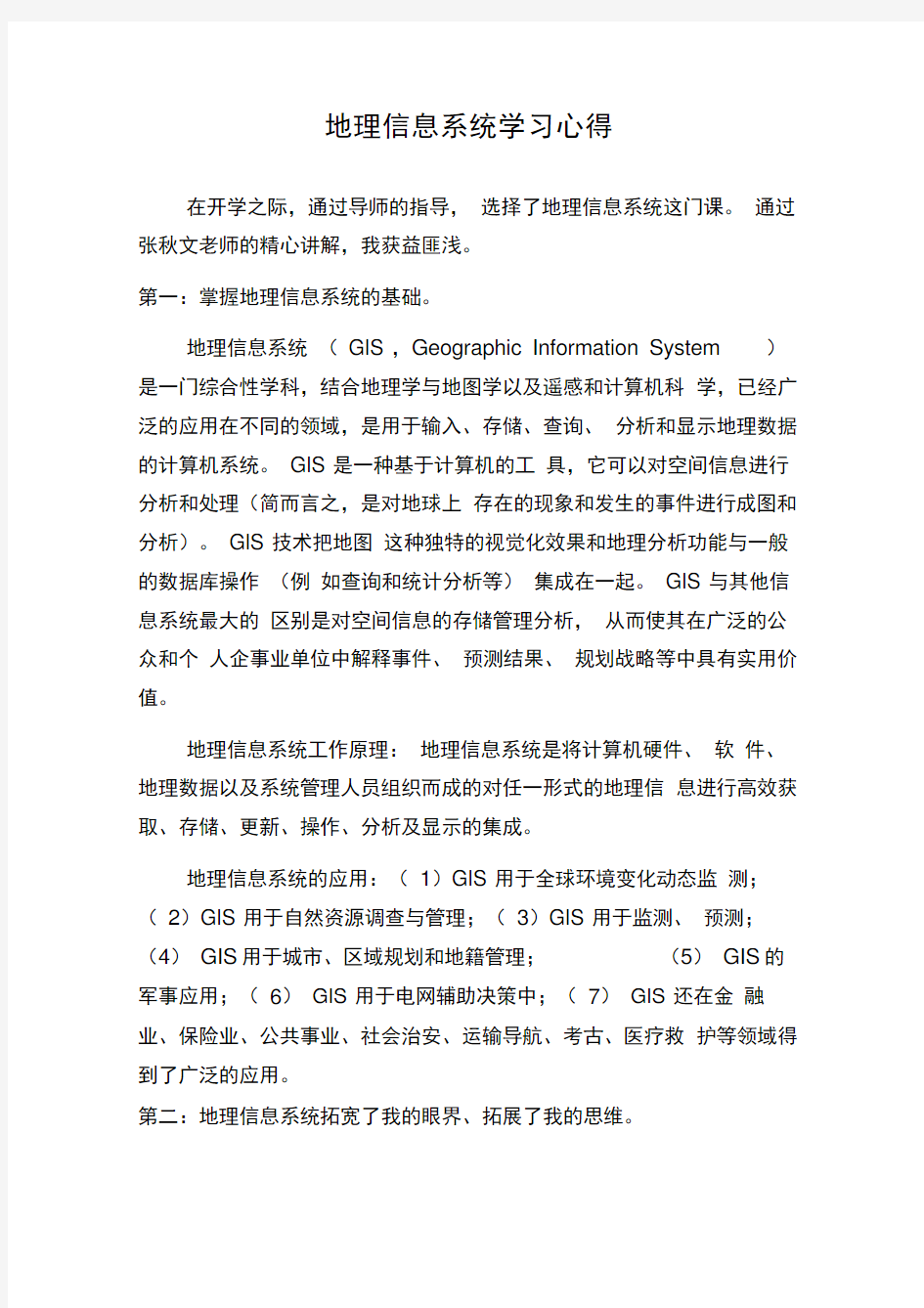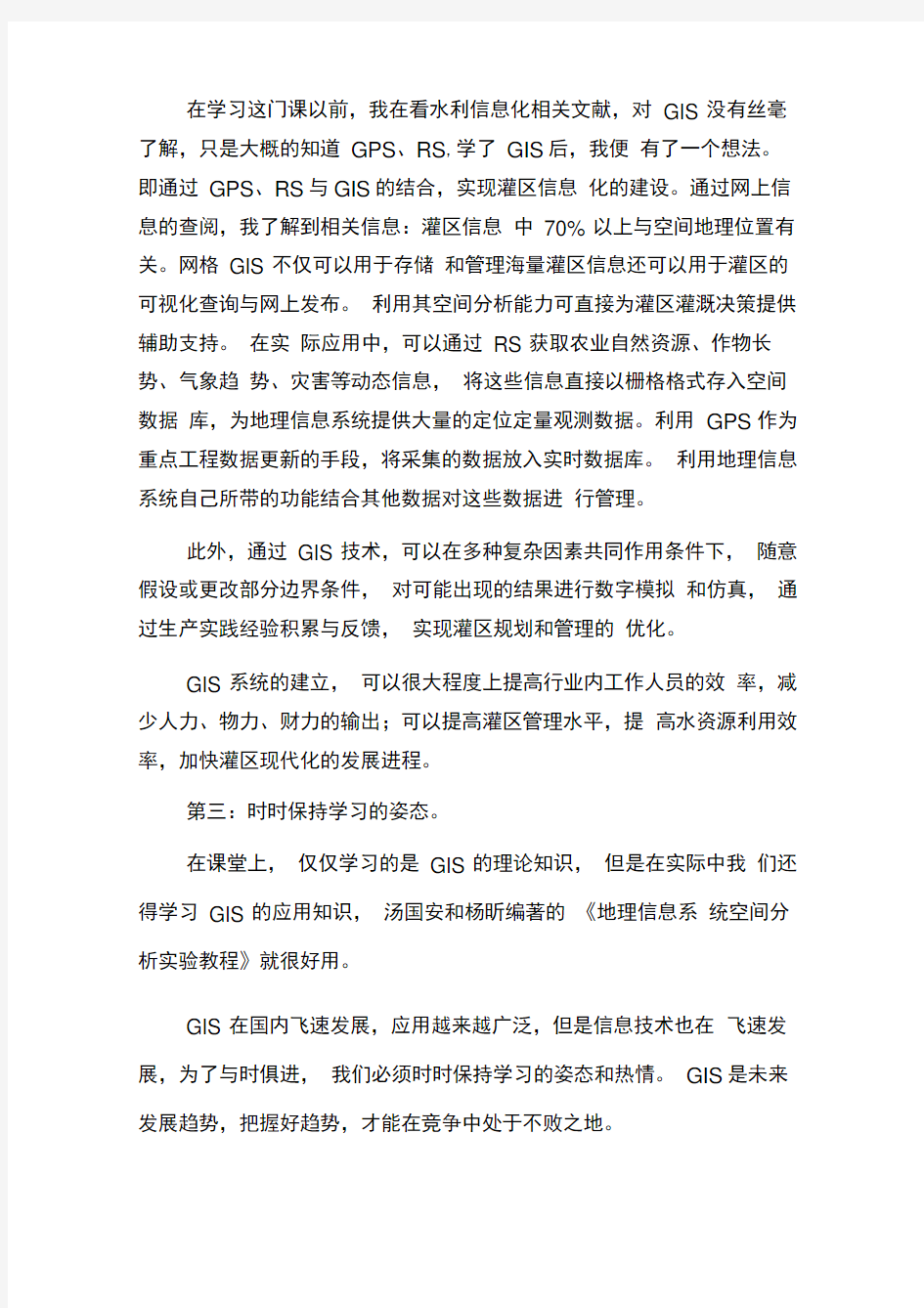地理信息系统学习心得


地理信息系统学习心得
在开学之际,通过导师的指导,选择了地理信息系统这门课。通过张秋文老师的精心讲解,我获益匪浅。
第一:掌握地理信息系统的基础。
地理信息系统(GIS ,Geographic Information System )是一门综合性学科,结合地理学与地图学以及遥感和计算机科学,已经广泛的应用在不同的领域,是用于输入、存储、查询、分析和显示地理数据的计算机系统。GIS 是一种基于计算机的工具,它可以对空间信息进行分析和处理(简而言之,是对地球上存在的现象和发生的事件进行成图和分析)。GIS 技术把地图这种独特的视觉化效果和地理分析功能与一般的数据库操作(例如查询和统计分析等)集成在一起。GIS 与其他信息系统最大的区别是对空间信息的存储管理分析,从而使其在广泛的公众和个人企事业单位中解释事件、预测结果、规划战略等中具有实用价值。
地理信息系统工作原理:地理信息系统是将计算机硬件、软件、地理数据以及系统管理人员组织而成的对任一形式的地理信息进行高效获取、存储、更新、操作、分析及显示的集成。
地理信息系统的应用:(1)GIS 用于全球环境变化动态监测;(2)GIS 用于自然资源调查与管理;(3)GIS 用于监测、预测;(4)GIS用于城市、区域规划和地籍管理;(5)GIS的军事应用;(6)GIS 用于电网辅助决策中;(7)GIS 还在金融业、保险业、公共事业、社会治安、运输导航、考古、医疗救护等领域得到了广泛的应用。
第二:地理信息系统拓宽了我的眼界、拓展了我的思维。
在学习这门课以前,我在看水利信息化相关文献,对GIS 没有丝毫了解,只是大概的知道GPS、RS,学了GIS后,我便有了一个想法。即通过GPS、RS与GIS的结合,实现灌区信息化的建设。通过网上信息的查阅,我了解到相关信息:灌区信息中70% 以上与空间地理位置有关。网格GIS 不仅可以用于存储和管理海量灌区信息还可以用于灌区的可视化查询与网上发布。利用其空间分析能力可直接为灌区灌溉决策提供辅助支持。在实际应用中,可以通过RS 获取农业自然资源、作物长势、气象趋势、灾害等动态信息,将这些信息直接以栅格格式存入空间数据库,为地理信息系统提供大量的定位定量观测数据。利用GPS 作为重点工程数据更新的手段,将采集的数据放入实时数据库。利用地理信息系统自己所带的功能结合其他数据对这些数据进行管理。
此外,通过GIS 技术,可以在多种复杂因素共同作用条件下,随意假设或更改部分边界条件,对可能出现的结果进行数字模拟和仿真,通过生产实践经验积累与反馈,实现灌区规划和管理的优化。
GIS 系统的建立,可以很大程度上提高行业内工作人员的效率,减少人力、物力、财力的输出;可以提高灌区管理水平,提高水资源利用效率,加快灌区现代化的发展进程。
第三:时时保持学习的姿态。
在课堂上,仅仅学习的是GIS 的理论知识,但是在实际中我们还得学习GIS 的应用知识,汤国安和杨昕编著的《地理信息系统空间分析实验教程》就很好用。
GIS 在国内飞速发展,应用越来越广泛,但是信息技术也在飞速发展,为了与时俱进,我们必须时时保持学习的姿态和热情。GIS是未来发展趋势,把握好趋势,才能在竞争中处于不败之地。
GIS learning experience
At the beginning of the term, through the guidance of my
instructor, I chose the GIS course. By teacher Zhang elaborate, I benefited.
First: to master the basis of geographic information system.
Geographic Information System (GIS) is a comprehensive discipline combining geography and map science and remote sensing and computer science. It has been widely used in different fields for inputting, storing, querying, analyzing and displaying Geographic data computer system. GIS is a computer-based tool that analyzes and processes spatial information (in short, mapping and analyzing phenomena and events that occur on Earth). GIS technology integrates maps with this
unique visualization and geo-analytic capabilities with common database operations such as querying and
statistical analysis. The biggest difference between GIS and other information systems is the storage management analysis of spatial information, which makes it have practical value in explaining events, forecasting results and planning strategies in a wide range of public and private enterprises.
How Geographic Information Systems Work: Geographic
Information Systems (GIS) is the integration of computer hardware, software, geo-data, and system administrators to efficiently capture, store, update, manipulate, analyze, and display any form of geographic information.
GIS application: (1) GIS is used for dynamic monitoring of global environmental change; (2) GIS is used for natural resource investigation and management;
(3) GIS is used for monitoring and forecasting; (4) GIS is used for urban and regional planning And cadastral management; (5) military applications of GIS; (6) GIS for power grid decision-making; (7) GIS is also used in the fields of finance, insurance, public utilities, social security, transport navigation, archeology and medical rescue Has been widely used.
Second: GIS has broadened my horizons and thinking.
Before I take this course, I was looking at the related literature of water informatization. I did not know anything about GIS. I just knew about GPS, RS, and after learning GIS, I had an idea. Through the
combination of GPS, RS and GIS, to achieve the construction of irrigation information. Through the online information access, I learned that the relevant information: more than 70% of the information in the irrigation
area and the geographical location of the space. Grid GIS can not only be used to store and manage information on a large number of irrigation districts, but also can be used for visual query and online publishing of irrigation districts. Using its spatial analysis capabilities, it can provide direct support for irrigation decision-making in irrigation districts. In practice, dynamic information such as agricultural natural resources, crop growth, meteorological trends and disasters can be obtained through RS. The information can be directly stored in a spatial database in a grid format to provide a large number of quantitative and directional observation data for geographic information system. The use of GPS as a key project data update means, the collected data into the real-time database. Use the capabilities of your own geographic information system to manage these data in combination with other data.
In addition, through GIS technology, some boundary conditions can be arbitrarily assumed or modified under the condition of multiple complex factors, digital simulation and simulation of the possible results can be carried out, and the practical experience and feedback of production can be used to realize the planning and management of the irrigated area optimization.
The establishment of the GIS system can greatly improve the efficiency of staff in the industry and reduce the output of manpower,
material and financial resources; improve the management level of irrigation districts, improve the utilization efficiency of water resources and accelerate the development of the irrigation area modernization.
Third: keep learning attitude.
In the classroom, just learning the theoretical knowledge of GIS,
but in fact we have to learn GIS application knowledge, Tang GuoAn
and Yang Xin 《GIS spatial analysis experiment tutorial 》is easy
s book to use.
GIS is booming in China and its application is more and more
extensive. However, information technology is also developing rapidly.
In order to keep pace with the times, we must keep learning attitude
and enthusiasm. GIS is the future development trend, grasp the trend,
in order to be invincible in the competition.
